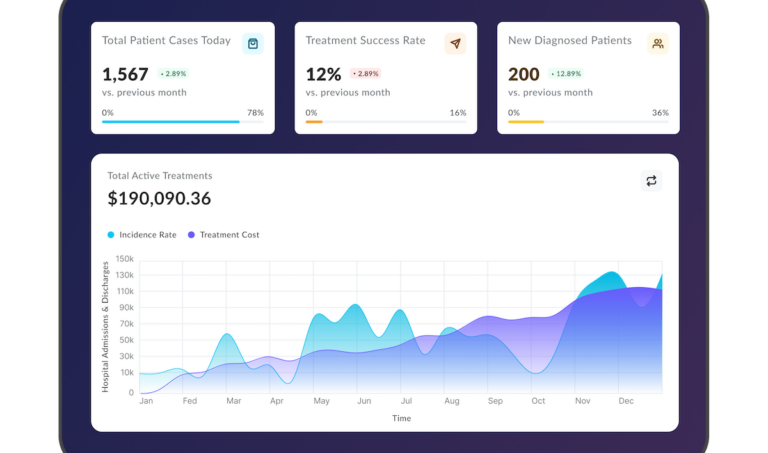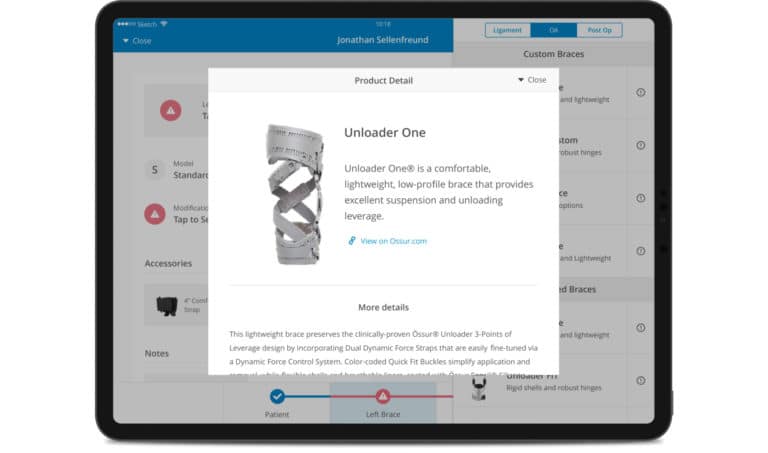How To Find and Hire an Offshore Software Development Team in 2025
Updated: June 4, 2025
As we navigate through 2025, the global economy continues to face unprecedented challenges last year, with the ongoing war, looming recession, and Silicon Valley Bank collapse impacting businesses worldwide.
In light of these economic uncertainties, it’s crucial for startup founders and business leaders to be more conscious about their expenditures and prioritize profitability. One highly effective strategy to persevere in 2025 is to leverage offshore software development services. The already popular outsourcing business model has skyrocketed during COVID-19 and reached $440 billion. And over $122 billion of that comes from the offshore model. Offshore development allows companies to continue building digital solutions and innovating without sacrificing quality while saving money.

We provide companies with senior tech talent and product development expertise to build world-class software. Let's talk about how we can help you.
Contact usBut how do you find the right offshore team that has the domain and tech expertise you seek, fits your budget, and that you can rely on? To help you, we’ll guide you through the process of hiring a remote dedicated team, delving into the details of where to find top-notch talent and what are the top outsourcing destinations.
Table of Contents
What is an Offshore Development Team?
Offshore development or offshoring is one of the outsourcing models that implies collaboration with a third-party vendor in another country to build software solutions. The term offshore emphasizes the significant distance and potential time zone differences between you and the offshore dedicated team of developers. For instance, the US-based company outsourcing to Ukraine its product development is an example of offshore collaboration.
A Deloitte report shows that 76% of companies prefer outsourcing IT functions, including cybersecurity services, app development, and IT infrastructure services. Moreover, offshore developers offer more than just creating an application from scratch. They can also provide specialized services such as back-end and front-end web development, UI/UX design, DevOps, quality assurance, and product management.
To better understand the benefits you can gain from working with an offshore software development team, let’s explore the primary reasons that make offshoring an attractive option.
The Key Benefits of an Offshore Dedicated Team
The global market has seen a surge in demand for offshore development services, which is evident in their growing revenue. A rapid expansion in the outsourcing services market witnessed $572 billion in 2025 and is predicted to surpass $1 trillion with a CAGR of 8.06%. Furthermore, the offshore outsourcing model dominated the market and is expected to lead in the following years.
These figures indicate that outsourcing, particularly offshoring, is not just a trend but gradually replacing conventional collaboration models. Multiple factors make offshore development more lucrative for businesses than hiring in-house staff. So, let’s discover them.
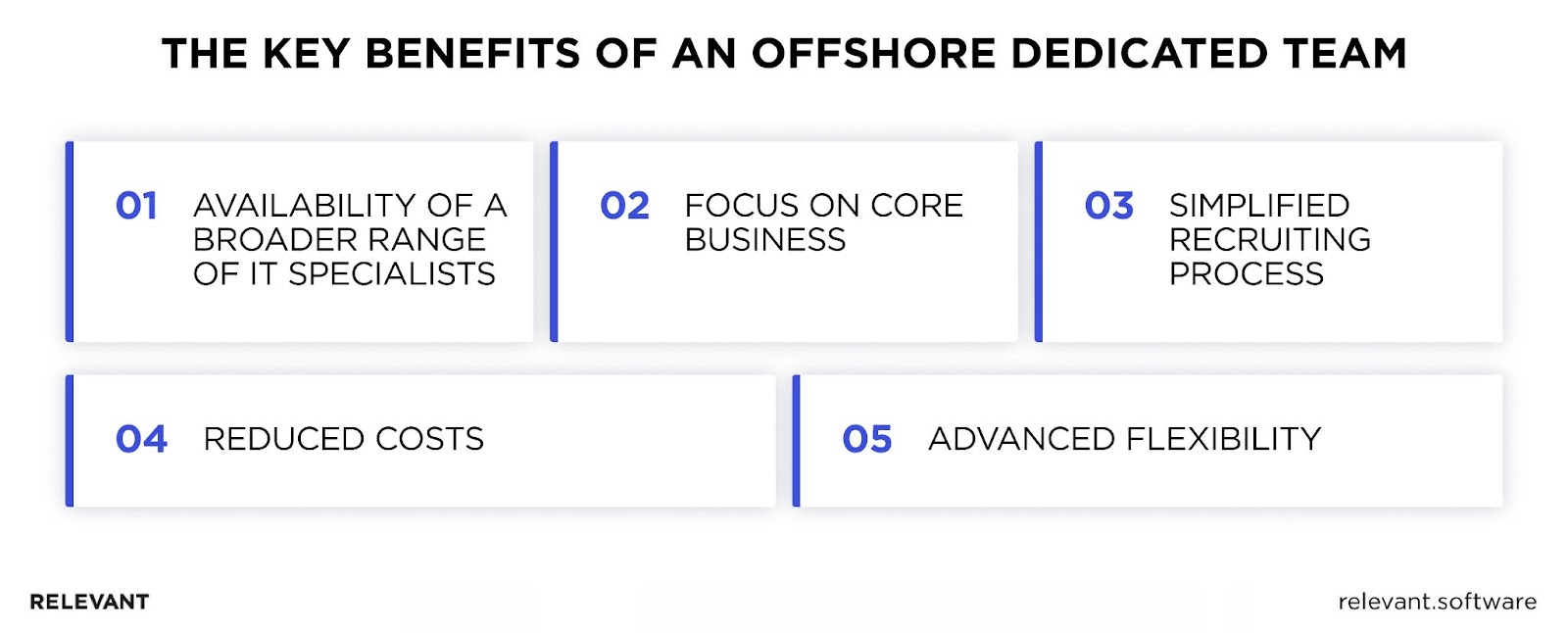
- Availability of a broader range of skilled IT specialists
Dedicated offshore teams offer business leaders access to over 26.9 million software developers globally, as opposed to limitations of local IT professionals’ availability. Western Europe and the US are facing a prolonged talent shortage. Finding good developers became tough even for the best recruiters. But by opting for the offshore outsourcing model, you can easily fill the skills gap in your company.
- Reduced costs
Offshoring offers the significant advantage of high cost-efficiency primarily due to the lower salary expectations of developers in regions such as Eastern Europe and Asia. These skilled developers, who may have lower pay demands than US-based engineers, have enough expertise and experience to develop cutting-edge projects. So you can strike a favorable balance between your investments and returns.
In fact, the remote work model itself saves you considerable costs. By employing remote teams, businesses could save from 32% up to 43% on real estate expenses alone. With such potential savings, it’s definitely worth considering hiring and managing offshore teams, don’t you think?
- Focus on core business
The outsourcing company handles the whole project development process. So, you don’t need to manage the project routines or worry about employee retention and other HR stuff. This helps you focus on core business aspects since your offshore partner will be responsible for everything else.
- Advanced flexibility
Businesses can experience peaks and troughs, so having the ability to scale up and down on demand is vital. When your business grows, you can easily expand your capacity to handle larger volumes of work by hiring an offshore team. This allows you to involve additional resources in work more quickly and effortlessly than hiring in-house staff.
The same thing is with the software development process. Indeed, you may not need the entire team from the start of the project, but at each stage, you can bring in the necessary specialists. Your provider may hire offshore developers, whole units, or individuals, taking the staff administration and management from you. Hiring remote developers provides your team with exceptional flexibility, which can give you a competitive edge.
- Simplified recruiting process
Offshoring frees you from the routine operations of hiring tech professionals: reviewing resumes, conducting interviews, and organizing staff training. You only need to state your goals, and the offshore web development company will find and provide candidates with relevant competencies and organize their workflow, speeding up their adaptation to the project. Thus, from the moment you sign a collaboration contract to the actual start of work will take no more than two weeks.
So, you only need to find a reliable outsourcing partner and choose the most qualified tech talent. Fortunately, you don’t have to go it alone.
Where to find an offshore software development team?
Offshore development is undoubtedly a beneficial business model both for large corporations and startups, but where to search for top talent? There are at least five options that will help you find potential partners. Let’s see them all in detail.
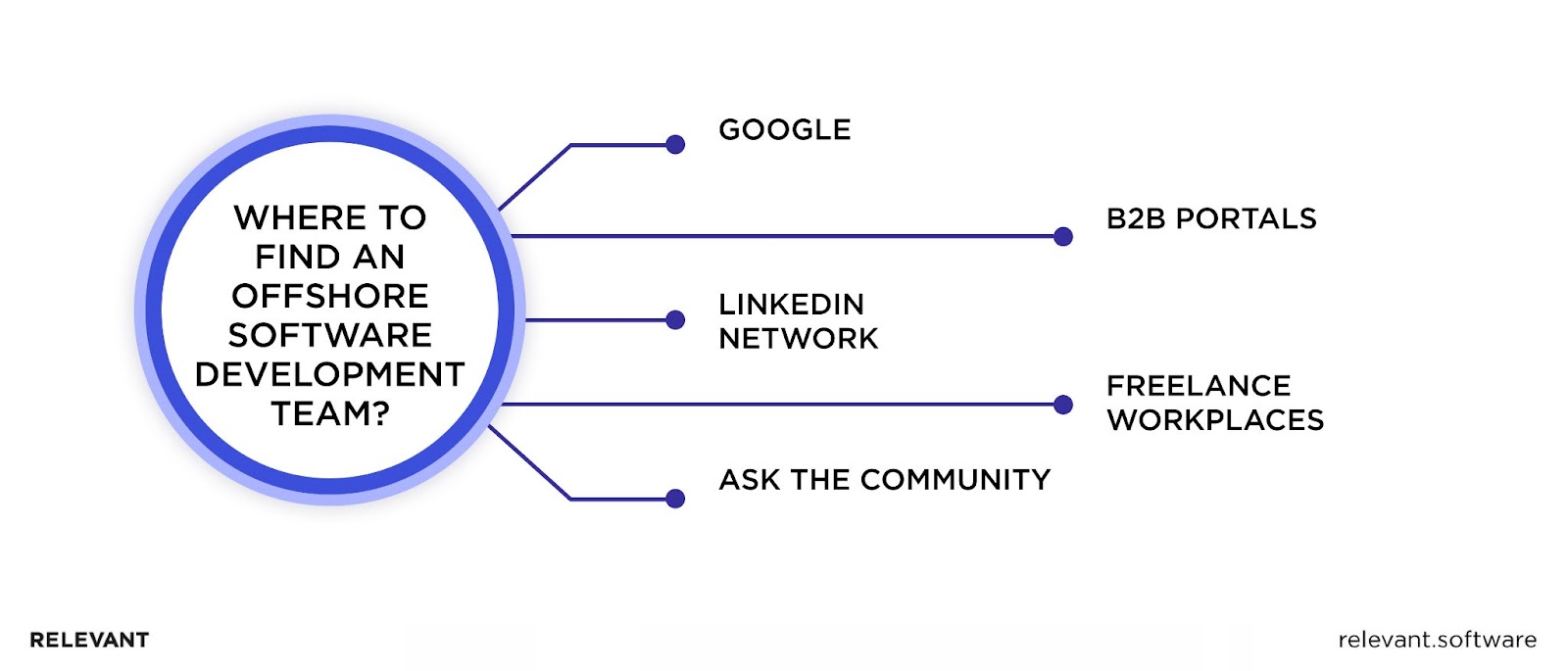
It might be too obvious, and you may think it’s meaningless. Still, Google can be an invaluable resource for reaching an offshore development company using the right search terms. To help you refine your search, consider entering keywords relevant to your software development needs. Some general keyphrases like “hire offshore developers” or “software development services” will provide you with billions of results.
That’s why to narrow down your search, add a more concrete description regarding the type of your project, your domain, the particular expertise you are looking for, or a region you would consider outsourcing. For instance, “fintech software development services in Ukraine” or “hire a dedicated offshore software development team specializing in logistics software development services in Eastern Europe” will give you more relevant results. By honing in on your search objective, you can quickly discover potential dev teams that align with your requirements, making your quest efficient and effective.
Freelance workplaces
If you are looking for a small development team or just one-two tech experts to fill the talent gaps in your project development team, working with freelance developers might be a cost-effective and convenient solution. Freelance websites such as Upwork, Toptal, Arc, and YouTeam were created specifically for finding a remote workforce. You may find more detailed information on these platforms in our in-depth comparison of Upwork vs. Toptal vs. Arc.
You can review portfolios, ratings, and reviews to make an informed decision. The platforms handle the administration of your collaboration with freelancers so that you can concentrate on the project’s progress.
However, keep in mind that working with intermediary platforms will ultimately increase the costs in exchange for security and reliability. Another problem with freelancers is more complicated task management and coordination as opposed to working with an outsourced development team.
B2B portals
Clutch and Goodfirms are amazing portals at providing information on hundreds of software development companies. Every reputable and trustworthy tech company is listed on at least one of these B2B platforms.
A convenient filter system allows you to narrow your search to just a few options that fit your business needs by sorting companies based on hourly rates, technologies, service types, and industry focus. They are great for finding specific expertise and customer reviews. Moreover, with over a million user visits monthly, Clutch and similar portals are bound to double-check and verify all the information companies share and clients’ reviews.
LinkedIn network
With its vast user base and specialized tools, LinkedIn has become a powerhouse for professional networking and talent sourcing. This platform can be your secret weapon in connecting with top-notch tech professionals and companies from around the globe. Let’s explore some of the most effective ways to leverage LinkedIn in your search for software engineers:
- Company pages on LinkedIn offer general information about their size, location, and industry. There you can also learn about a company’s expertise and overall performance. Furthermore, you can delve into the profiles of individual employees to get a sense of their experience and background, making it easier to identify the ideal offshore development partner.
- LinkedIn groups are hubs for professionals with shared interests and goals. By joining groups related to software development, outsourcing, or dedicated offshore teams, you can tap into a rich pool of potential candidates and like-minded individuals. Participate in group discussions, share your project requirements, and learn from the experiences of others who have successfully found offshore developers. Networking in these groups can also lead to valuable recommendations and connections.
- LinkedIn’s search is effective for narrowing down potential offshore developers. By utilizing keywords, filters, and location preferences, you can pinpoint professionals or companies that meet your specific criteria.
- Engage with industry experts. LinkedIn is home to countless thought leaders and industry experts. By engaging with their content, you can gain valuable insights and stay updated on the latest trends in offshore software development.
- Connection requests and direct messages. Once you have identified potential candidates or companies, send personalized connection requests or InMails to initiate a conversation. Highlight mutual interests, demonstrate your understanding of their work, and express your desire to discuss potential collaboration opportunities. Building genuine relationships and showcasing your value proposition can greatly enhance your chances of finding the perfect offshore software development team.
As you see, LinkedIn can be an invaluable tool in your search for talented software developers and in discovering top-tier tech companies. With good research and evaluation, LinkedIn can assist in finding the best offshore programmers.
Ask the community
The power of community can help you tap into the expertise and experiences of others to find the perfect offshore software developers for your project. Here are some ideas on how to do that:
- Social media platforms like Facebook, Twitter, and LinkedIn are great tools for reaching out to your network and beyond. Create a post saying that you’re searching for offshore developers and ask your friends, followers, and connections to share their experience of working with a software development agency, where did they find them, and provide references if there are any.
- Forums. Several question-and-answer platforms like Quora and Reddit can provide helpful insights and recommendations to help you make an informed decision. Search for topics related to offshore development and read through the threads to find recommendations, tips, and success stories. Additionally, check more tech-related online communities like Stack Exchange and StackOverflow, where you can find useful information on software development best practices or find your potential IT experts.
- Industry events and meetups bring together people with similar interests and experiences, so there are more chances to find industry experts and potential tech partners who can help you achieve your goals. Moreover, attending all those technical-related seminars and talks will help you learn more about the latest trends in the software development and tech sectors.
How to hire the best offshore software developers
Now, let’s move on to practice. Below, we outlined the essential steps to take to ensure a productive collaboration with dedicated offshore teams and, ultimately, successful product development.
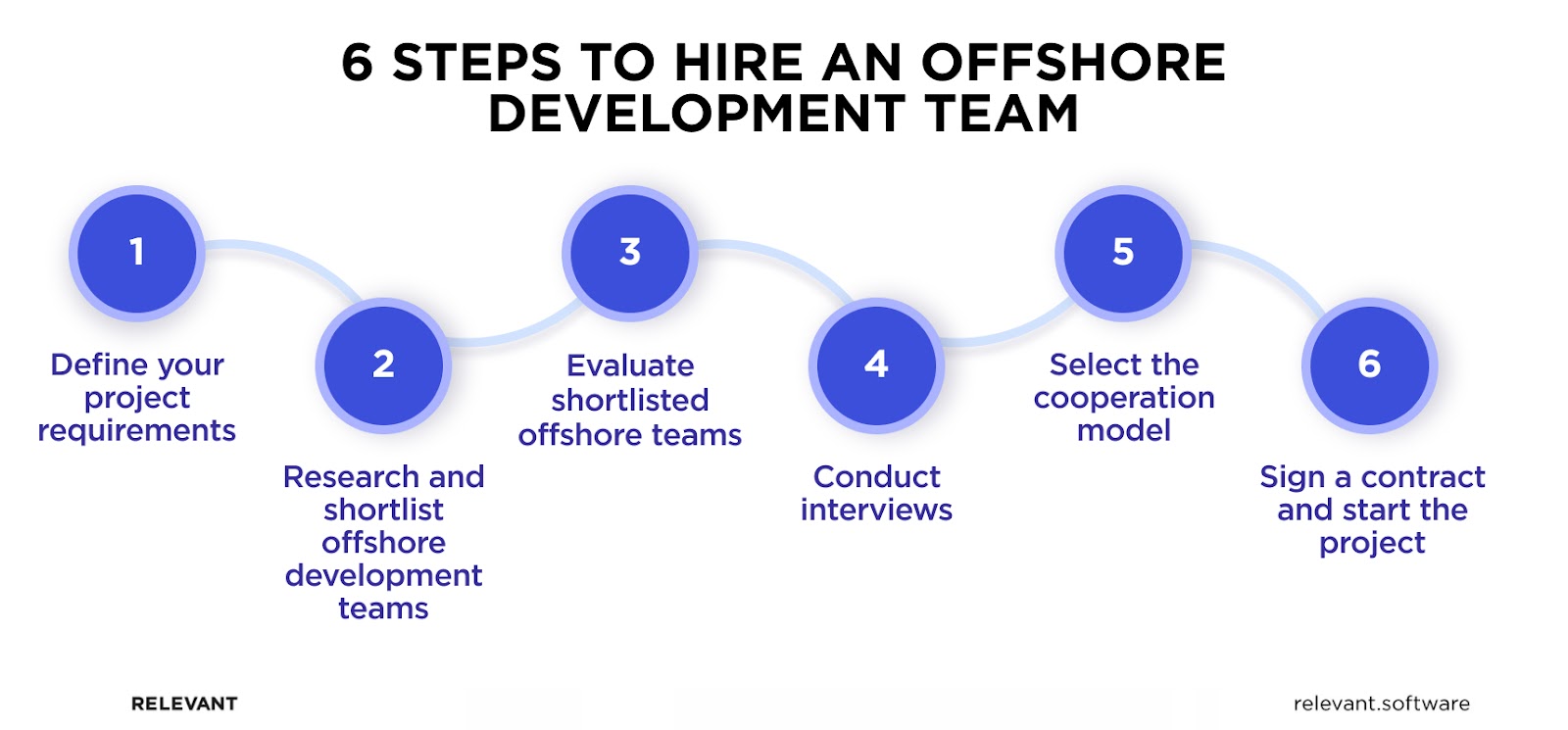
Define Your Project Requirements
The essence of collaboration with the offshore team is a top-quality product. To achieve that, you should clearly define and communicate your goals, expectations, and technical specifications to your development team. Here are some tips to help you:
1. Define clear goals
You should give a detailed and clear explanation of the underlying reasons and objectives of your project. Formulate goals that detail the project schedule, the problem it solves, and what is needed to complete it. By providing all this information to your dev team, you’ll avoid any miscommunication and get the desired outcomes.
2. Document the technical specifications
You should explain your product’s type, characteristics, features, design, and functions in detail so that your outsourced team can build the app that you need. Consider it a document that outlines your product expectations, vision, and deliverables. We suggest you break down a project scope into smaller and measurable milestones with deadlines. Thus, you’ll simplify monitoring the progress and increase your chances of finishing the project on time and within budget.
Also, don’t forget to specify a technology stack for your future product. When you know what frameworks and technologies you want to use, you’ll have a better idea of what kind of developer you need.
3. Estimate time and budget
Upon establishing a project scope, assess the rough time and budget required to complete your project. This will help you plan your resources and set realistic expectations.
4. Gather relevant info
Collect any information related to your project, if there is any, including:
- Design examples
- Competitor analysis
- Personal preferences
If you don’t have enough data to describe your project requirements, consider engaging your potential vendor for a product discovery phase.
Find more tips and best practices for creating technical requirement documents in our guide on writing software requirement specification.
These steps will help you find the right offshore development partner for your project more quickly and organize smooth hiring and product development right from the start. Having a clear understanding of your end goal can help prevent any future challenges with your remote team.
Research and Shortlist Offshore Development Teams
Once you know what will be the final product and how to build it, devote time to looking for companies that are experts at those exact things. While researching, pay attention to their location, hourly rates, team expertise, and company portfolio.
Check your potential partners’ portfolios and if they have similar projects. Read feedback from former clients. Also, take notice of the company’s values and business culture, as they are important factors for ensuring smooth communication and processes.
At this stage, you’ll narrow the search and make a shortlist of the best-fitting software development companies overseas.
Evaluate Shortlisted Offshore Teams
Assess the shortlisted companies by focusing on the following criteria:
- Technical skills. Learn about their technical skills and their efficiency in integrating the latest technologies and tools.
- Time zone difference. It’s wise to ensure that your working hours overlap. Ensure that your business hours overlap with the office hours of the offshore developers.
- Language compatibility. Undoubtedly, collaborating with your remote dev team is much more productive when there is no language barrier.
- Costs. You may ask each potential company to estimate the project based on your requirements and perform a test task. Thus, you’ll figure out the best price-to-quality ratio of the selected companies that will help you make the final selection.
By doing so, you’ll get a deep insight into how the offshore teams work, their attitude toward clients, and how effective their solutions are.
Conduct Interviews
Conduct a technical interview to assess their skills and filter out the best ones. You can do it through an online coding assessment test or by asking them to complete a short test that won’t take more than 4 hours. This will help you assess their proficiency in specific programming languages, tools, and frameworks to define the best talents.
In addition to technical skills, it’s important to evaluate the non-technical aspects of a potential offshore software development team. This includes their soft skills, decision-making abilities, and communication skills. Non-technical interviews will give you a better understanding of the team’s work style and overall fit with your project.
During the interview, ask teams to explain complex technical concepts in simple terms to test their communication skills. Also, pay attention to their responsiveness and how well they listen to your needs and concerns.
Remember to choose a team that not only has the technical skills but also fits well with your vision and company culture.
Select the cooperation model
A key to your successful partnership is the choice of the right collaboration model. The most common models in practice in the tech market nowadays include:
- Fixed price. This model is a perfect fit for short-term projects with well-defined requirements and acceptance criteria. You fully entrust the project to the service provider that bears the responsibility for the project’s success. Both parties agree on a predetermined cost for completing the entire project. It minimizes financial risks yet sacrifices flexibility as any changes require a complex change-approval process.
- Dedicated development team. If your project is lengthy and demands continuous innovation and adaptation, the dedicated development team model is the way to go. This option involves hiring a specialized team of engineers who work exclusively on the project from start to finish. You pay a monthly salary for the workload of the entire team.
- Time and material (T&M) model. Under this flexible model, you pay for the actual time and resources spent on your project. This approach enables you to remain actively involved in the development journey, making it ideal for projects that may encounter unexpected changes or require iterative improvements. Also, it allows you to adjust requirements as you go.
| Fixed price | Dedicated team | T&M | |
| Size of project | Small and medium | Large | Small and medium |
| Requirements | Predefined | Evolving | Not set |
| Flexibility | Little | High | High |
| Budget | Predefined | Estimated | Not set |
| Client’s control | Little | Not set | Not set |
Each offshore software development cooperation model offers its unique allure, catering to different project needs and preferences. Now, you can make an informed decision and create partnerships that lead to successful software development outcomes.
Sign a Contract and Start the Project
It’s crucial to lay a strong foundation by signing a contract that ensures mutual protection and understanding. This final stage of the offshore team hiring process is an opportunity to solidify work conditions, address legal concerns, and build trust and transparency with your partner.
A well-drafted contract is a cornerstone of any successful collaboration. So, make sure it clearly outlines the following key aspects:
- Hourly rates and timeframe estimates
- Payment details
- Product ownership
- Warranties
- Legal compliance
When you engage an offshore team, you grant them access to sensitive information and valuable insights about your business operations, which can be confidential. So, signing a Non-disclosure Agreement (NDA) is essential for safeguarding your intellectual property and preventing unauthorized data disclosure. After completing these formalities, your remote dev team is ready to start the project.
Top Locations to Hire Offshore Team
With a plethora of talent available globally, you have the freedom to hire offshore developers from diverse locations. However, you should choose a location that perfectly balances cost efficiency, technical expertise, and cultural compatibility. Here are some top offshore software development destinations to consider, each offering unique benefits and opportunities for your business.
Eastern Europe
Outsourcing to Eastern Europe gains popularity as businesses benefit from a growing pool of highly skilled developers who are well-versed in various latest technologies. The most popular Eastern European countries, Ukraine, Poland, Bulgaria, the Czech Republic, and Romania, have stamped their spots in the IT outsourcing market.
With a strong emphasis on education and a shared cultural affinity with Western Europe and North America, this region offers both technical expertise and ease of communication. English proficiency is generally high, ensuring smooth collaboration between your in-house and offshore teams. Setting an offshore development center in Eastern Europe makes sense due to its growing talent pool, tech proficiency, and rapidly evolving IT industry.
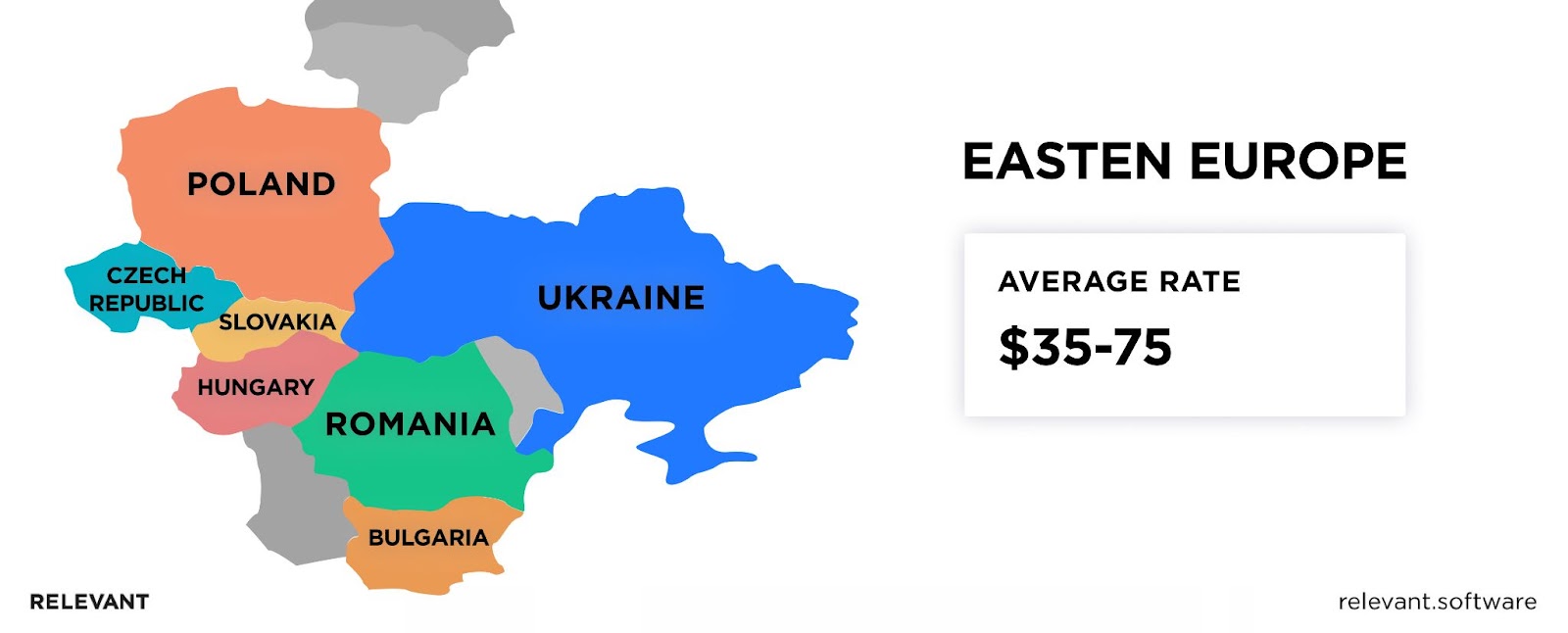
Latin America
Countries such as Argentina, Brazil, and Mexico are fast becoming hotspots for offshore development primarily due to the minimal time difference for US-based companies. Their proximity to North America and a growing number of highly skilled developers make Latin America appealing to businesses seeking cultural compatibility and technical expertise.
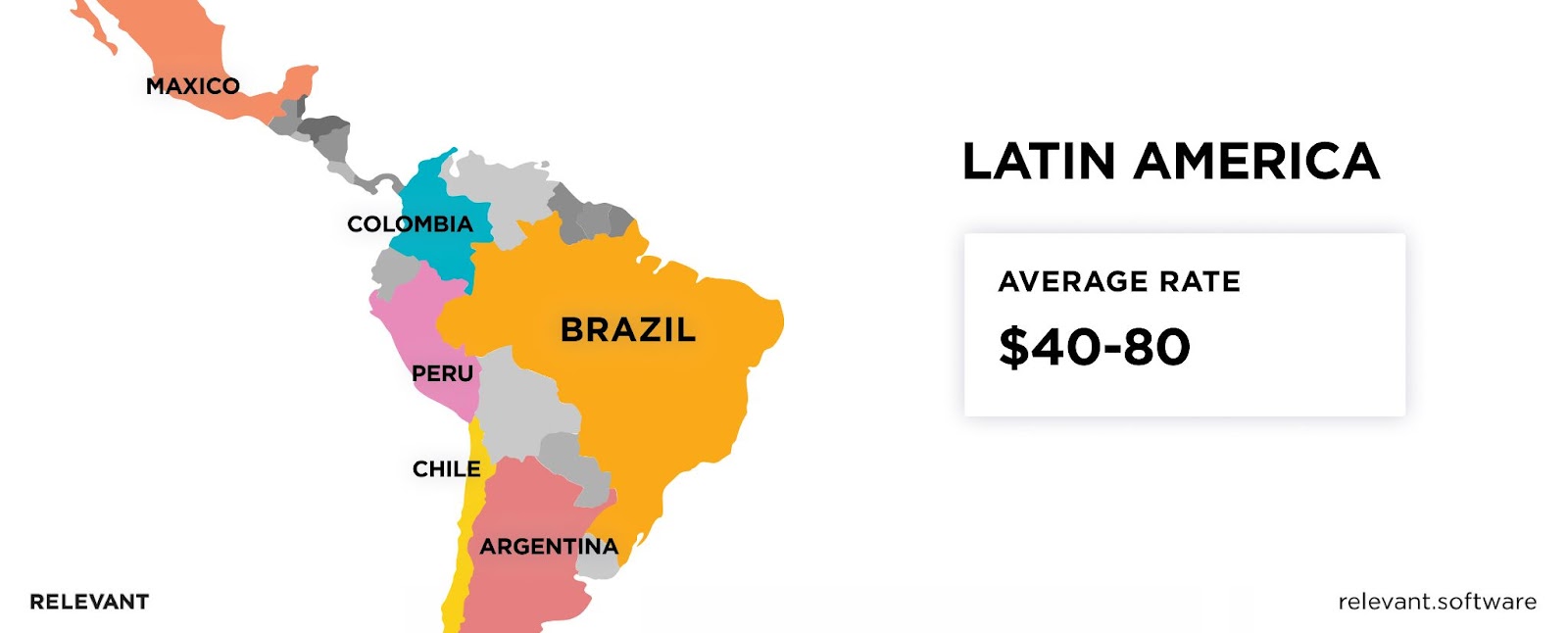
Asia
Asia has long been the go-to destination for companies seeking cost-effective offshore development solutions. The most significant advantages you’ll gain from outsourcing to Asia are a vast talent pool and competitive pricing that can help you optimize resources. India has the largest number of developers – around 5.8 million. Although cultural and language barriers can be a concern, many Indian developers have moderate to good English skills and are increasingly adapting to the global work culture.
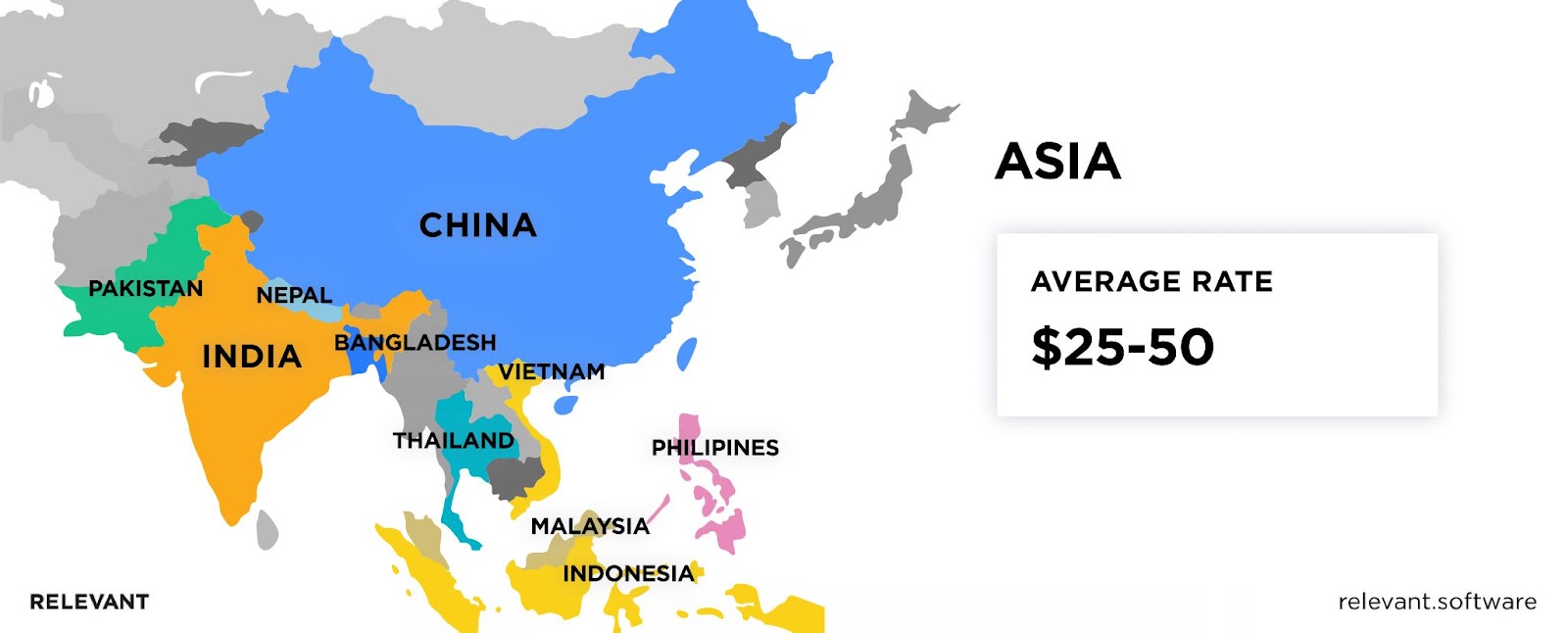
So, how to choose the perfect location for hiring a remote dev team? We suggest you pay attention to such factors:
- An average pay rate
- The IT community strength
- Positions in IT ratings
- Legal aspects
- Command of English
- Working hours overlap
- Cultural compatibility.
How Much Does it Cost to Hire Offshore Developers?
There are numerous factors to consider when choosing a country for offshore development. But let’s face it, businesses opt for offshore outsourcing to optimize costs, so the rates usually dictate the final decision on the location.
Regions with less developed economies, such as LATAM, Asia, and Eastern Europe, are often characterized by lower development rates and more specialists compared to the US, Western Europe, Australia, and others. So, let’s overview the hourly rates in those locations against North America to see the contrast.
| Tech specialist | North America | Eastern Europe | Latin America | Asia |
| Architect | $98-$210 | $59-$91 | $61-$99 | $47-$82 |
| Business Analyst | $78-$144 | $36-$78 | $40-$76 | $35-$65 |
| Project Manager | $62-$168 | $44-$75 | $53-$82 | $35-$69 |
| Graphic Designer | $114-$185 | $36-$75 | $35-$82 | $28-$41 |
| DevOps | $98-$102 | $52-$75 | $38-$53 | $45-$99 |
| Senior Developer | $114-$170 | $53-$76 | $35-$59 | $49-$82 |
| Senior QA Engineer (manual) | $72-$114 | $39-$58 | $24-$46 | $42-$71 |
| Senior QA Engineer (automated) | $72-$114 | $44-$73 | $29-$59 | $49-$80 |
Source: Global Software Outsourcing Trends and Rates Guide
Hire Offshore Development Team with Relevant Software
Exploring the vast global talent pool in search of a top-notch offshore development team can be a real struggle. But it’s worth the effort. Moreover, adhering to our recommendations allows you to streamline the process and discover the perfect team for your project faster and more efficiently. Remember, hiring exceptional tech professionals involves strategic planning, thoughtful communication, and a keen eye for spotting talent. Use these guidelines to increase your chances of finding the ideal offshore team that aligns with your project requirements, business needs, and company culture.
Relevant’s proper project management and world-class dedicated software development team are just some reasons to contact us to discover more. Don’t put your project on hold. Delegate its development to Relevant and get the work started in a few weeks!
any with a well-established name in Lviv, Ukraine. We’re also members of the Lviv IT Cluster, the most prominent business Ukrainian community of IT companies, authorities, and educational institutions.
Our core services:
Do you want a price estimate for your project?
Do you know that we helped 200+ companies build web/mobile apps and scale dev teams?
Let's talk about your engineering needs.
Write to us